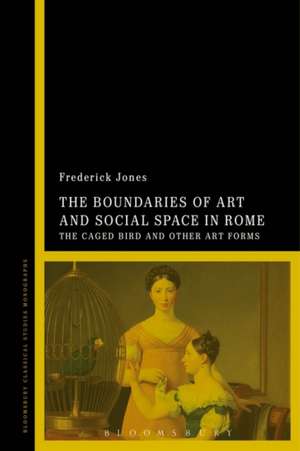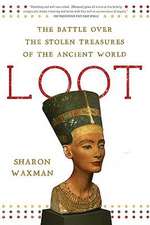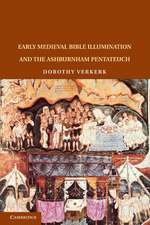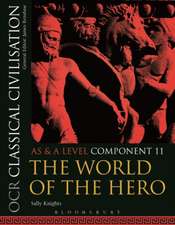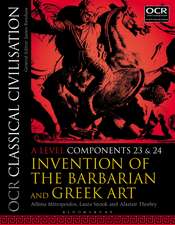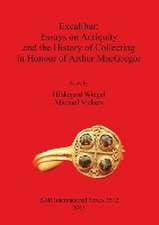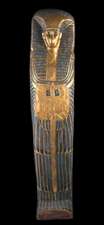The Boundaries of Art and Social Space in Rome: The Caged Bird and Other Art Forms
Autor Dr Frederick Jonesen Limba Engleză Hardback – 5 oct 2016
| Toate formatele și edițiile | Preț | Express |
|---|---|---|
| Paperback (1) | 236.45 lei 6-8 săpt. | +85.36 lei 5-11 zile |
| Bloomsbury Publishing – 18 apr 2018 | 236.45 lei 6-8 săpt. | +85.36 lei 5-11 zile |
| Hardback (1) | 772.91 lei 6-8 săpt. | |
| Bloomsbury Publishing – 5 oct 2016 | 772.91 lei 6-8 săpt. |
Preț: 772.91 lei
Preț vechi: 1112.41 lei
-31% Nou
Puncte Express: 1159
Preț estimativ în valută:
147.92€ • 153.86$ • 122.11£
147.92€ • 153.86$ • 122.11£
Carte tipărită la comandă
Livrare economică 14-28 aprilie
Preluare comenzi: 021 569.72.76
Specificații
ISBN-13: 9781472526120
ISBN-10: 1472526120
Pagini: 208
Ilustrații: 25 bw illus
Dimensiuni: 156 x 234 x 16 mm
Greutate: 0.47 kg
Editura: Bloomsbury Publishing
Colecția Bloomsbury Academic
Locul publicării:London, United Kingdom
ISBN-10: 1472526120
Pagini: 208
Ilustrații: 25 bw illus
Dimensiuni: 156 x 234 x 16 mm
Greutate: 0.47 kg
Editura: Bloomsbury Publishing
Colecția Bloomsbury Academic
Locul publicării:London, United Kingdom
Caracteristici
Includes an original and broad contextualisation of ancient art
Notă biografică
Frederick Jones is Senior Lecturer in Classics in the School of Archaeology, Classics and Egyptology at the University of Liverpool, UK.
Cuprins
1 Introduction: Art2 The Roman Garden3 The Garden Room at Prima Porta4 Tapestry in Rome5 The Caged Bird6 Conclusion: Self-Projecting Inside and OutBibliography
Recenzii
The topic and title are hugely engaging, and Jones' combined literary and art historical approach has much to recommend it.
The monograph comprises six chapters that delve into providing rich source evidence from ancient literature and material culture . There are some incredibly salient discussions and analyses that Jones formulates in this monograph. Moreover, it is a commendable work that will drive specialist audiences to engage further in the topics of boundaries, garden spaces, and cognitive development in Roman art and literature.
Jones performs an admirable service in this book by drawing our attention to artifacts that are not usually considered in tandem, and by expanding our view of what we might consider 'Roman art' in the process.
This is an excellent, bouncy book - the better for not being over meaty and for making its points briskly and with liveliness. It uses the visual and environmental arts - from garden painting in the domestic villa, via actual gardens, and tapestry to the uses of caged birds in the household, all in relation to the literary texts about such materials, in order confront some of the deeper meanings of Roman culture in social space. Its range of themes and their discussion present a deft but at the same time profound reflection on the boundaries of art in the Roman world.
What constitutes art in the Roman world? This complex question is at the heart of Jones' new book, which offers an ambitious reflection on the boundaries of art in the Roman imagination . This book succeeds in its central tenet of investigating the boundaries of art . The use of cross-media evidence makes the book approachable to scholars of both literature and material culture; and the emphasis on nature and cognitive awareness in three of the test-cases will make it especially appealing to those interested in landscape, spatial studies, and psychogeography.
The monograph comprises six chapters that delve into providing rich source evidence from ancient literature and material culture . There are some incredibly salient discussions and analyses that Jones formulates in this monograph. Moreover, it is a commendable work that will drive specialist audiences to engage further in the topics of boundaries, garden spaces, and cognitive development in Roman art and literature.
Jones performs an admirable service in this book by drawing our attention to artifacts that are not usually considered in tandem, and by expanding our view of what we might consider 'Roman art' in the process.
This is an excellent, bouncy book - the better for not being over meaty and for making its points briskly and with liveliness. It uses the visual and environmental arts - from garden painting in the domestic villa, via actual gardens, and tapestry to the uses of caged birds in the household, all in relation to the literary texts about such materials, in order confront some of the deeper meanings of Roman culture in social space. Its range of themes and their discussion present a deft but at the same time profound reflection on the boundaries of art in the Roman world.
What constitutes art in the Roman world? This complex question is at the heart of Jones' new book, which offers an ambitious reflection on the boundaries of art in the Roman imagination . This book succeeds in its central tenet of investigating the boundaries of art . The use of cross-media evidence makes the book approachable to scholars of both literature and material culture; and the emphasis on nature and cognitive awareness in three of the test-cases will make it especially appealing to those interested in landscape, spatial studies, and psychogeography.
